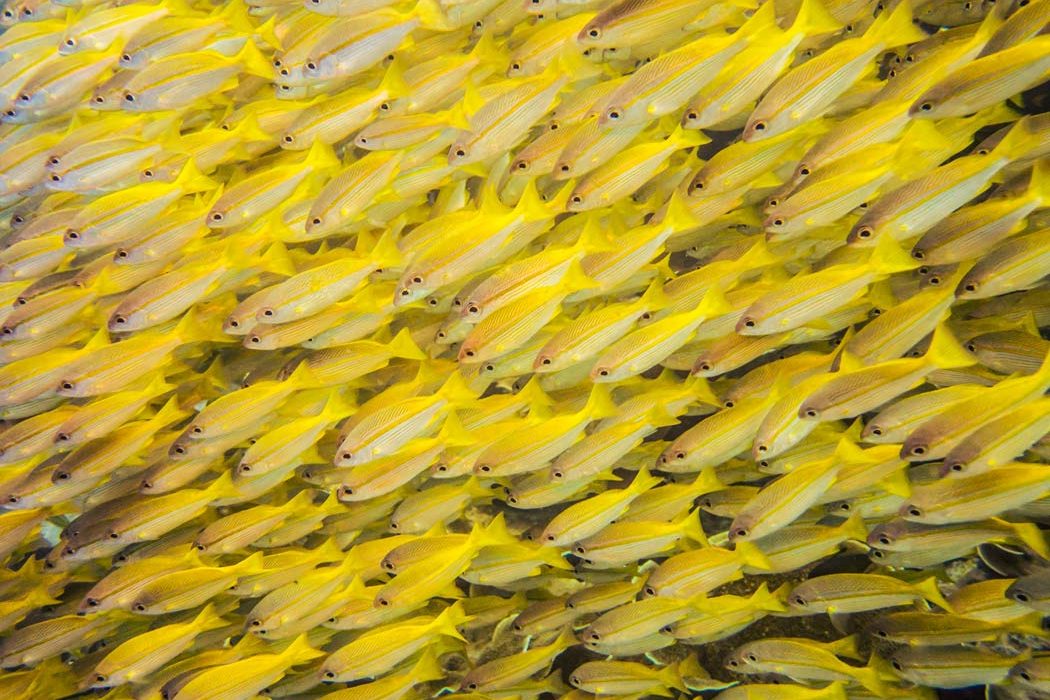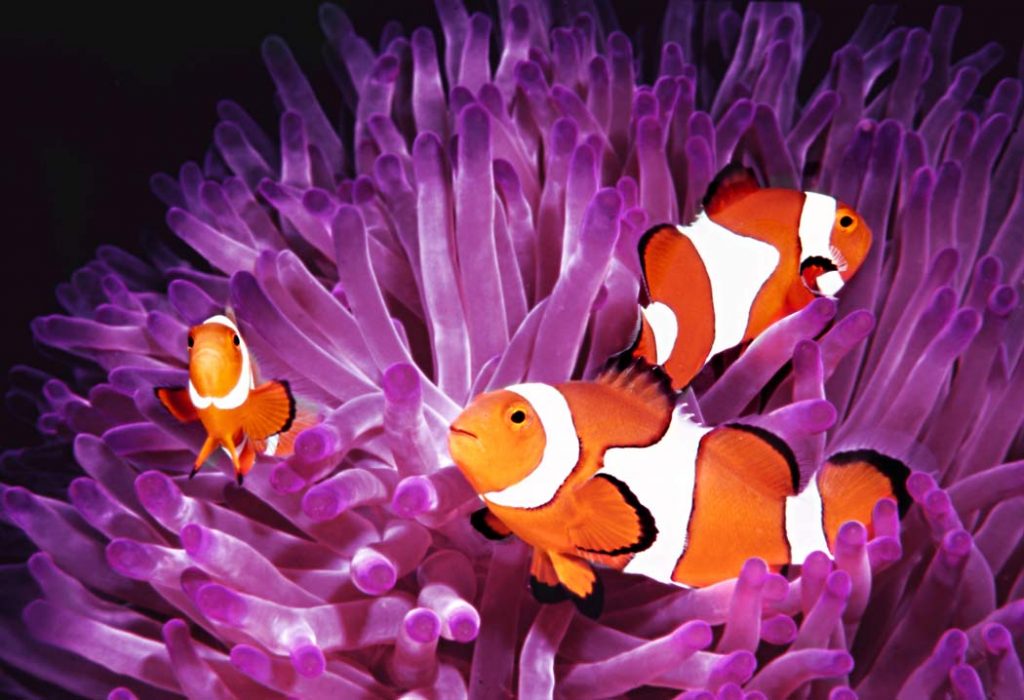Here’s a question for you: In addition to living in water, whale sharks, manta rays, moray eels, groupers, gobies, rainbow trout and sea horses have what in common? Clearly these animals vary in size. Some live along the seafloor, while others live in the water column and roam the open sea. Most live in salt water, but one lives in freshwater streams. Some, but not all, are filter feeders. Before you hurt your brain trying to come up with the answer, let me tell you that the answer I am looking for is that all of these creatures are fishes. If you did not realize that, do not despair. You have a lot of company. While many divers know that groupers and gobies are fishes, a whole lot of people fail to realize that sharks, rays, eels and even sea horses are also fishes. To be clear, sharks, rays, eels and sea horses are not just closely related to fishes, they are 100 percent fish.
So, here’s a follow-up question: What makes a fish a fish? In other words, what characteristics do fishes share that cause scientists to consider them closely related and distinguishable from other animals? Think about that one for a few minutes. What does a whale shark, the world’s largest fish, which can attain a length of 50 feet (15 m) and weigh as much as 30,000 pounds (13,500 kg), have in common with a moray eel and a full-grown goby that is smaller than your little finger? Then consider angelfishes, snappers, rockfishes, pipefishes, anemonefishes, ocean sunfish, marlins, sailfish, triggerfishes, trumpetfishes and myriad other species, and try to come up with a simple definition of a fish. That’s a relatively simple question that can stress your brain.
I once attended a class at Scripps Institution of Oceanography, in which the professor began by telling us that while almost everyone seems to think they know exactly what you are talking about when you say the word “fish,” very few people can give you a simple definition of what a fish is. He followed that comment by telling the class that the best definition of a fish that he ever heard was that a fish is just about any animal a credentialed ichthyologist wants to call a fish.
The animals we call fishes occur in seemingly endless combinations of shapes and sizes. Some live out in the open ocean and never see the seafloor. Others live in deep waters and never see the surface or even the light of day. Still other species live in reef communities, kelp forests or on the seafloor. Some are carnivores, while others are herbivores, and still others are omnivores, animals that feed on both plants and animals. Some fishes spawn in large groups and never see their mates again. Others mate for life. Some lay eggs, others bear live young. Some species provide a considerable amount of parental care, while others never give that notion any obvious consideration.

If it makes you feel better, here is a little more concrete definition of a fish. A fish is any of a large group of cold-blooded, finned, aquatic vertebrates that respire by passing oxygenated water over gills. If you apply this definition to whale sharks, manta rays, moray eels, groupers, tunas and all of the other species I have mentioned thus far, I think that you would have to agree that this definition works. And from this definition, it is easy to see why so many animals are called fishes. In fact, there are thought to be more than 27,300 species.
Specialists suspect that fishes first appeared in the waters of Earth about 500 million years ago in what they contend was a rather miraculous form. Fishes were the latest, if you will, in animal design as they had their hard parts on the inside of their bodies, not on the outside. Until that point, there were soft-bodied animals like amoebas and jellyfishes, and lots of armored hard bodies, but there had been no animals with the hard parts on the inside. But almost overnight, as if not trusting this experiment, Mother Nature also gave fishes some hard external parts such as scales and spines. Whether this development occurred because of some genetic mutations or by design remains a topic of debate.
Modern Fishes
Modern fishes are divided into three classes:
- Agnatha, the jawless fishes.
- Chondrichthyes, jawed fishes that possess skeletons made of cartilage; and sharks, rays, skates and ratfishes.
- Osteichthyes, jawed fishes that have skeletons made of bone.
As divers we don’t have much, if any, contact with the primitive jawless fishes (also known as roundmouth fishes) that comprise the class Agnatha. The approximately 75 species of hagfishes and lampreys are the only living representatives of this once large class.
Worldwide, there are roughly 1,200 species of cartilaginous fishes, and all are described in the class Chondrichthyes. Many of these, especially a variety of sharks and rays, are among the oceans’ more spectacular creatures. I think any diver that has encountered a manta ray, squadron of spotted eagle rays cruising through the blue, whale shark, school of scalloped hammerhead sharks, or any of a number of other species ranging from mako sharks to southern stingrays would surely agree.

As the name suggests, the skeletons of cartilaginous fishes are made of cartilage, not bone. Some common distinguishing characteristics of sharks, rays and their kin include the lack of the swim bladder found in many bony fishes; that males fertilize females internally; the possession of five to seven gill arches; and that their skin is composed of toothlike denticles that give the skin an abrasive texture.
There are more than 20,000 species of bony fishes, and all are described in the class Osteichthyes. Bony fishes are so called because their skeletons are calcified, making them much harder and less flexible than those of cartilaginous fishes. Bony fishes appear in a staggering variety of shapes, sizes and colors as almost any scuba diver will attest. Bony fishes can be found in most freshwater and saltwater habitats. Many species are equipped with sophisticated organs, and they display behaviors that help them deal with their surroundings in a number of very clever ways. Many bony fishes show great maneuverability and speed. They are also characterized by the possession of highly specialized mouths equipped with protrusible jaws and the possession of a swim bladder, an internal organ that helps control their buoyancy.
Fish Sense
As is the case with any complex animal, in large part a fish’s ability to survive depends upon its ability to acquire information from its surroundings through its sensory system, and then, analyze that input. Fishes are equipped with the senses of sight, smell, touch, feel and taste, thus they can detect light, chemicals and vibrations. When considering the usefulness and importance of each sense, it is helpful to keep in mind that it is the combination of senses that are used to interpret an animal’s surroundings, not each sense in isolation.
Many fishes have well-developed eyes and a keen sense of vision that they rely upon to find and capture food, avoid predation, locate shelter and find a mate. Many fishes see color and some are able to see in very low light levels.
In general terms, vision in fishes is on par with vision in humans, but their eyes are quite different from ours. Their lenses are spherical, a design that enables a fish to focus in water. Focus is accomplished by moving the lens toward or away from the retina instead of stretching the lens, as is the case in human eyes. Fishes cannot dilate or contract their pupils, but the eye size tends to increase the deeper a species tends to occur, the lower the general light level of its surroundings, and the more active it is at night.
Sharks and many other fishes have a specialized structure known as the tapetum lucidum in the eye that amplifies incoming light. Those species that have this structure can often be detected on night dives by noting the strong reflection of the eyes when illuminated by a dive light.
As illustrated by their keen senses of taste and smell, fishes have well-developed chemoreception. They possess a pair of nostrils on each side of their head. An organ known as the olfactory rosette is used to detect the presence of chemical stimuli, and the size of this internal organ is roughly proportional to a given fish’s ability to smell. Sharks, eels, salmon and other fishes are legendary for their sense of smell, a sense that in some instances can detect chemical levels as low as one part per billion.
Fishes also have the ability to taste, and they have taste buds on their lips, tongue and mouth. However, in many species the sense of taste is not as keen, or relied upon as heavily, as other senses — a fact that surprises many people. Species such as sawsharks, nurse sharks, goatfishes and catfishes also possess chemosensory barbells (whisker-like appendages on the chin that are equipped to taste chemicals in their surroundings).
You have probably never seen a fish’s ear, but fishes do have ears. The reason you might not have seen them is that fishes’ ears are internal organs. Like the jobs performed by human ears, fish ears help give the animals their sense of balance as well as facilitate hearing.
Fishes possess another sense of mechanoreception that in simplistic terms is somewhat of a mix of hearing and touch. This sensory system is known as the lateral line. This “line” is a group of very sensitive “hair cell” organs that allow fish to “feel” their surroundings by detecting movement and vibrations. This is very similar to the way we hear, and that is why the lateral line system is said to be a cross between hearing and touch. Some ichthyologists teach that the lateral line gives fishes the sense of “distant touch.” Schooling fishes rely on this sense for their near-instantaneous, synchronized movement. The organs that comprise the lateral line system run along the length of a fish’s body.
In addition to the previously discussed senses, sharks, rays and skates are also equipped with the sense of electroreception, an ability that enables them to detect the electrical fields created anytime a nearby creature contracts a muscle or beats its heart. In fact, cartilaginous fishes can detect electrical fields that are 10,000 times fainter than any other known group of animals can detect. To detect the electrical fields, sharks and their kin use numerous gel-filled pit organs called ampullae of Lorenzini that are concentrated around the head and snout. Electroreception is also used to gain orientation when navigating by detecting and analyzing slight variations in the Earth’s magnetic field.
How Fishes Swim
As a snorkeler and diver you have surely noticed that the density of water makes movement difficult, yet fishes can move rather quickly while expending minimal effort. Swimming fishes rely upon their muscles for power and their fins for thrust and directional control. When swimming, the skull serves as a fulcrum and stabilizes the body, and the vertebrae act as levers for movement.
Comprising close to 80 percent of the body of many fishes, muscles provide power. Fins provide a vehicle that allows the fish to exert the thrust provided by the muscles. The structure of the scales and skin, as well as a coat of mucus in some species, helps reduce water resistance. In simplistic terms, when thrust is greater than drag, or resistance from the water, you have a swimming fish.
Some fishes such as tunas, jacks, marlins and open-ocean sharks are built to sustain continuous aerobic movement as they are near-constant cruisers, while other, more sedentary species, such as groupers and gobies are known as burst swimmers. Of course, different body shapes also play a role in the speed and efficiency with which fishes swim.
The swim bladder is a sac inside the abdomen of many bony fishes that contains gas. This gas is exchanged between a fish’s bloodstream and the swim bladder depending on whether the fish wants to ascend, descend or maintain neutral buoyancy.
Oxygen is the largest percentage of gas in the bladder, while nitrogen and carbon dioxide fill in passively. Fishes that migrate vertically tend to have higher oxygen levels in their swim bladders because oxygen fills in faster and leaves faster, while those species that tend to maintain a stable depth usually have more nitrogen in their swim bladders. Nitrogen is an inert gas that enters and exits slowly from the swim bladders and bloodstream.
Schooling
About 80 percent of fish species school as juveniles, while roughly 20 percent school as adults. Schools are said to be polarized if all of the individuals in the school face the same direction and move in near synchrony. A school is nonpolarized if the gathering individuals tend to move in many directions at the same time.
Exactly why some species school and others do not is a question that has gnawed at scientists for years, but a number of theories are generally accepted. The more important reasons for schooling are thought to be:
Anti-predation. Each member of the school gains an advantage against predation if the size of the school fools a potential predator into thinking that the school is a single large animal and when a predator has difficulty in selecting a single target in a school. Certainly the odds for any one fish in the school to be the selected target are reduced. In addition, the school has a lot more eyes and other senses to detect predators.
Access to mates is a significant advantage of schooling behavior.
Enhanced foraging is another advantage that can be derived from schooling. The sheer numbers of foraging fish in a school can overwhelm prey, or in the case of schooling surgeonfish, their numbers can overwhelm territorial damselfish, allowing the surgeons to get to the desired food sources in the damsel’s territory.
As is the case with bicyclers that draft the bike in front of them, a fish in a school can gain an energy-saving advantage by being pulled along in the water by the slipstream created by the fish in front of it.
The world of fishes is no doubt a fascinating realm. Scientists spend their entire careers studying fishes, and all will tell you that there is plenty more to learn. For divers, fishes are fun. They are beautiful, entertaining and intriguing creatures.
Which of the following are not fishes?
- Angelfish
- Horseshoe crab
- Jellyfish
- Manta ray
- Scorpionfish
- Shark
- Spotted snake eel
- Starfish
- Whale
- Whale shark
Answer: Horseshoe crab (crustacean), jellyfish (cnidarian), starfish (echinoderm), whale (cetacean)
Story By Marty Snyderman







